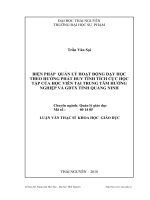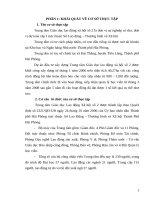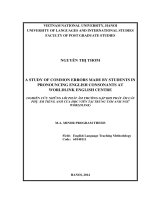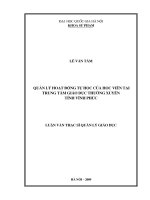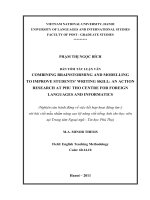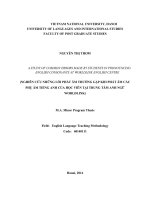Nghiên cứu những lỗi phát âm thường gặp khi phát âm các phụ âm tiếng anh của học viên tại trung tâm anh ngữ worldlink
Bạn đang xem bản rút gọn của tài liệu. Xem và tải ngay bản đầy đủ của tài liệu tại đây (435.43 KB, 51 trang )
i
ACKNOWLEDGEMENTS
I owe an enormous debt of gratitude to my supervisor, Dr. Ha Cam Tam for
her great guidance, precious comments and continuous encouragement from the
beginning and throughout the study process. Without her help, I could not finish my
graduation paper.
My sincere thanks go to all of my teachers of Post-Graduate Studies
Department in University of Languages and International Studies who have brought
me the world of knowledge during my course and helped me complete this
important document.
I also would like to send my appreciation to all of my students studying at
Worldlink English centre for their cooperation and enthusiastic help in recording
the tasks. I am indebted to my colleagues there who always supported and stayed by
my sides when I was in the most stuck.
Last but not least, I wish to send the deepest gratitude to my family for their
endless love and support throughout my life. Without the encouragement of my
grandmother, parents and brothers, I could not have got this far.
I am grateful to all of those who contributed to the completion of this study
and it is an honor for me to receive any comments from the readers.
ii
ABSTRACT
The research was conducted to examine the most problematic English
consonants facing the students at Worldlink English Centre. Consonantal phoneme
pronunciation error data was collected from the recording using two types of tasks,
namely reading out loud single words and reading out loud a story and analyzed
using narrow IPA phonetic transcription.
The findings indicate that learners at the centre have a tendency to
substitution, deletion and insertion of sounds in syllable-initial, middle and final
positions of the words. Specifically, it was found that the most common error was
sound substitution which most often happened to the affricate, fricative and lateral
sounds: /ʃ/, /ʒ/ and /l/. The second most popular error is called sound deletion,
which frequently occurred to three ending sounds: /p/, /s/, /tʃ/. Last but not least
most frequent error named sound insertion appeared when the participants added
the sound /s/ at the end of many words in the study. The errors were identified in
terms of both the interference of the mother tongue and inadequate knowledge of
the articulation of the sounds. From the results, some pedagogical suggestions were
offered to improve the English pronunciation of students at Worldlink English
Centre.
iii
TABLE OF CONTENTS
DECLARATION i
ACKNOWLEDGEMENTS ii
ABSTRACT iii
TABLE OF CONTENTS iv
PART I: INTRODUCTION 1
1. Rationale 1
2. Aims of the study 1
3. Scope of the study 2
4. Method of the study 2
5. Design of the study 2
PART II: DEVELOPMENT 4
CHAPTER I: LITERATURE REVIEW 4
1.1. English Pronunciation 4
1.2. The English Consonants 5
1.2.1. General description of consonants 5
1.2.2. Classification of English consonants 6
1.3. The Vietnamese Consonants 11
1.4. A comparison of English consonant and Vietnamese consonant 12
1.5. The interference of the mother tongue to students' English pronunciation 15
1.6. Intelligibility and Intelligibility problems in pronunciation 17
1.7. Preview of Previous studies 18
CHAPTER II: METHODOLOGY 21
2.1. Selection of Informants 21
2.2. Data collection instruments 22
2.3. Data collection procedure 24
2.4. Data analysis procedure 24
CHAPTER III: DATA ANALYSIS AND DISCUSSION 27
iv
3.1. Sound deletion errors 28
3.2 Sound substitutions 31
3.3. Sound insertion 34
PART III. CONCLUSION 35
1. Conclusion 35
2. Implications 37
3. Limitations and suggestions for further study 38
REFERENCES 40
APPENDIX 1: SINGLE WORDS AND STORY NARROW TRANSCRIPTION I
APPENDIX 2: EXERCISES FOR TAPE RECORDING IV
v
LIST OF TABLE, FIGURES AND ABBREVIATION
LIST OF FIGURES
Figure 1: Features of pronunciation
Figure 2: The manner of articulation
Figure 3: The manner of articulation
LIST OF TABLES
Table 1: English Consonant Phonemes
Table 2: Vietnamese initial consonants
Table 3: Vietnamese final consonants
Table 4: The initial consonants of the Hanoian variety
Table 5: Similarities between English and Vietnamese
Table 6: Overview of the consonant errors found in the data
Table 7: Types of consonant errors found in the data
Table 8: Sound deletion errors
Table 9: Sound substitution errors
Table 10: Sound insertion errors
vi
PART I: INTRODUCTION
1. Rationale
English has become the international language, which is popular all over the
world. In Vietnam, there is high demand for the language because more and more
requirements about English are established such as University English Outcomes
Standard or English Certificate to graduate or apply for a job. That is the reason
why learners go to English centers with the hope that they can gain knowledge and
get the best grades in the tests; as a result, English centers are getting popular in the
big cities in Vietnam. However, it is the fact that the serious problem of Vietnamese
English learners is their pronunciation. Not only does this restrict learners in real
communication but also reduce their grades in important speaking and listening
tests. For such reasons, basic pronunciation courses are provided to students
learning at English centers. Over several years of teaching English, especially basic
pronunciation courses to Vietnamese learners at some English centers, the
researcher of this paper has realized that many Vietnamese learners of English made
errors in pronouncing English consonants, which leads them to the failure in
comprehension or misunderstanding in communication. The causes of those
pronunciation errors are various; however, the influence of mother tongue is of
great concern to the researcher. In attempt to find out common errors by students in
pronouncing English consonants and figure out whether or not the native language
affects students' pronunciation of the second language, the researcher carries out
this study.
2. Aims of the study
The aim of the study is mainly to figure out common errors in pronouncing
English consonants by the learners taking part in English basic pronunciation
courses at Worldlink English Centre. Basing on the identified errors, the causes,
especially, the influence of mother tongue on learners' pronunciation will be
discussed and some pedagogical suggestions will be provided to improve teaching
and learning English pronunciation courses at the centre.
The study, therefore, answers the following question: What common errors
do students at Worldlink English Centre have in pronouncing English consonants?
1
3. Scope of the study
The main focus of this study is on investigating common errors made by
students in pronouncing twenty four English consonants. Basing on the results, the
question of whether or not Vietnamese language influence the English
pronunciation of the students at Worldlink English Centre is also discussed
and answered.
Participants are 20 non-English major students who are learning basic
pronunciation courses at Worldlink English centre. Textbook for teaching the
course is English Pronunciation in Use – Elementary by Jonathan Marks.
4. Methodology of the study
The data was collected by employing the tool of recording the participants'
pronunciation of single words and story reading. All the data collected are presented
in the form of narrow transcription and then compared to the standard version to
find out the errors. Details of methodology applied in the study are discussed in Part
III - Methodology
5. Design of the study
To achieve the aims of the study, this paper is divided into five chapters.
Part I: Introduction: An introduction consists of the rationale, aims of the
study, scope of the study, method and organization of the study.
Part II: Development
Chapter I: Literature Review: This chapter provides the relevant bodies of
knowledge and gives a brief overview of the literature on the research topic. This
includes key concepts of English pronunciation, intelligibility in pronunciation,
English consonants, Vietnamese and English consonant comparison and contrast,
English pronunciation errors and related key terms. Besides, the viewpoints on the
interference of the first language to the second language pronunciation are also
given. The last part is the review of previous related studies.
Chapter II: Methodology: This part describes all the steps used to complete
the research including in-depth information of participant selection, applying data
collection instrument, procedure of data collection and data analysis.
2
Chapter III: Results and discussion: All the results regarding
pronunciation errors made by students in pronouncing English consonants are
presented. To what extends the native language causing student's difficulty in
pronouncing English consonants is also discussed in this part.
Part III: Conclusion provides a summary of the significant findings in the
paper. The benefits as well as limitations of the study are discussed to draw out
precious lessons and suggestions for further studies. Bibliography and Appendices
are included after this chapter.
In this chapter, the rationale, aims, significant, scope and method of the study
are stated. The next chapter will be the literature review on topic related issues.
3
PART II: DEVELOPMENT
CHAPTER I: LITERATURE REVIEW
The aim of this chapter is to analyze the relevant bodies of knowledge and
give a brief overview of the literature on the research topic. Firstly, key concepts of
English pronunciation, intelligibility in pronunciation, English consonants,
Vietnamese and English consonant comparison and contrast, English pronunciation
errors and related key terms will be explained critically. Secondly, the interference
of mother tongue in English pronunciation acquisition will be discussed to indicate
the impacts on learners’ pronunciation learning and sound producing. Finally, an
overview of studies related to common errors made by learners in pronouncing
English consonants will be given. Throughout the review, gaps in the current
knowledge will be filled.
1.1. English Pronunciation
In order to have an insight into the study, it is necessary to understand the
main features of pronunciation. Pronunciation refers to the production of sounds
that human use to make meaning. Generally, it includes segmental and
suprasegmental aspects. Segmental features are the particular sounds of a language
(segments) while suprasegmental features are aspects of speech beyond the level of
the individual sound, such as intonation, phrasing, stress, timing, rhythm. These are
different aspects of pronunciation but all work in combination when we speak.
Regarding the combination of segmental and suprasegmental features in
pronunciation, Jenkins and Setter (2005, p.1) provide a clearer definition of
pronunciation:
“Pronunciation involves the production and perception of segmental
(sounds), both alone and in the stream of speech, where they undergo number of
modifications and interact with suprasegmental (prosodic) features, particularly
stress and intonation”.
More particularly, Kelly (2000) presented the main features of English
pronunciation in the figure below:
4
Figure 1: Features of pronunciation
(Adapted from Kelly, 2000)
1.2. The English Consonants
1.2.1. General description of consonants
Among features of pronunciation, the current study concerns with only
sounds ( or phonemes), particularly the consonants. It is necessary to understand
what the term "consonant" exactly means.
Roach(1983) gives an example in his book English Phonetics and Phonology
to define consonant. “If we make a sound like s or d, it can be clearly felt that we
are making it difficult or impossible for the air to pass through the mouth” (p.10).
Unlike vowel, consonants are the sounds in which there is obstruction to the flow of
air as it passes from the larynx to the lips.
Sharing the same idea with Roach (1983), Kelly (2000) supposes that
“Consonant sounds are formed when the airflow is interrupted, restricted or diverted
in variety of ways” (p.10). The formation of consonants is mentioned in this
definition.
As cited in the book named The Cambridge Encyclopedia of the English
Language written by Crystal (2003), ‘from a phonetic point of view, consonants are
articulated in one of two ways: either there is a closing movement of one of the
vocal organs, forming such a narrow constriction that it is possible to hear the sound
of the air passing through; or the closing movement is complete, giving a total
blockage. The closing movement may involve lips, tongue, or throat, but in each
5
case the overall effect is very different from the relatively open and unimpeded
articulation found in vowels”(p.242).
In short, the “obstruction”, “interruption”, “blockage”, “restriction” of the
airflow is the key words to define consonant. Specifically, consonants are the
sounds in the production of which one articulator moves towards another or two
articulators come together, obstructing the air-stream and the air-stream can’t get
out freely.
1.2.2. Classification of English consonants
There are 24 consonant sounds in most English accents, conveyed by 21
letters of the regular English alphabet. “To differentiate the 24 consonants form
each other, phoneticians use a classification based on the place and manner of
articulation, in addition to the criteria of whether they are voiced or voiceless”
( Crystal, 2003,p.243). To be more specific, there are three ways of describing the
consonant sound, namely the manner of articulation (the interaction between the
various articulators and the airstream), the place of articulation (the description for
more detailed information about what the various articulators actually do) and the
force of articulation (the strong or fortis and weak or lenis form of the consonants).
Kelly (2000) provides the detailed description of the manner of articulation, the
place of articulation and voicing, as below:
1.2.2.1. The manner of articulation
The manner of articulation refers to how the sound is made, at the various
locations in the vocal tract.
Figure 2: The manner of articulation
Manner of articulation
Plosive A complete closure is made somewhere in the vocal
tract, and the soft palate is also raised. Air pressure
increases behind the closure, and is then released
‘explosively”.
Affricate A complete closure is made somewhere in the
mouth, and the soft palate is raised. Air pressure
increases behind the closure, and is then released
more slowly than in plosive.
6
Fricative When two vocal organs come close enough together
for the movement of air between them to be heard.
Nasal A closure is made by the lips, or be the tongue
against the palate, the soft palate is lowered, and air
escapes through the nose.
Lateral A partial closure is made by the blade of the tongue
against the alveolar ridge. Air is able to flow around
the sides of the tongue.
Approximant Vocal organs come near to each other, but not so
close as to cause audible friction.
1.2.2.2. The place of articulation
The place of articulation identifies where in the vocal tract the sound is
made, and which vocal organs are involved.
Figure 3: The manner of articulation
Place of articulation
Bilabial Using closing movement of both lips
Labio-dental Using the lower lip and the upper teeth
Dental The tongue tip is used either between the teeth or close to
the upper teeth
Alveolar The blade of the tongue is used close to the alveolar ridge
Palato-alveolar The blade(or tip) of the tongue is used just behind the
alveolar ridge
Palatal The front of the tongue is raised close to the palate
Velar The back of the tongue is used against the soft palate
Glottal The gap between the vocal cords is used to make audible
friction
1.2.2.3. Voiced and Unvoiced
Voicing can refer to the articulatory process in which the vocal cords vibrate.
Voiced consonants are produced when the vocal cords are vibrating while voiceless
consonants are produced when the vocal cords are not. Many consonant sounds
come in pairs. They are produced in the same place in the mouth with the tongue in
7
the same position but the only difference between them is that one is an unvoiced
sound (no vibration of the vocal cords) while the other is a voiced sound (vocal
cords vibrate).
Voicing, manner and place of articulation are together summarized in the following
table:
Table 1: English Consonant Phonemes
Place of Articulation
Bilabial Labio-
dental
Dent
al
Alveolar Palato-
alveola
r
Palata
l
Velar Glottal
Plosive p b t d k g
Affricate
tʃ dʒ
Fricative f v θ ð s z
ʃ ʒ
h
Nasal m n ŋ
Lateral l
Approximant w r j
1.2.2.4. Phonological Rules
A phonological rule is a method for describing the way in which individual
sounds are produced in spoken language. The sound alternations regularly occur in
connected speech. Phonological rules can be divided into four types: assimilation,
elision and linking. Roach (1983) clearly discussed and demonstrated those types in
his book named English phonetics and Phonology. Firstly, assimilation happens
when a sound changes and one of its features will be more similar to an adjacent
sound. In other words, when two words come together, the sound of one word can
cause changes in sounds belonging to neighboring words. Roach (1983) emphasized
that assimilation "is more likely to be found in rapid, casual speech and less likely
in slow, careful speech".(p.124). The final consonant /t/ in the word that, for
example, will become /p/ before a bilabial consonant, as in: that person
/ðæp
pɜːsən/.
Secondly, in speaking, there are a number of phonemes which are not
actually pronounced and this is called elision. For instance, in words like potato,
tomato, today, the vowel in the first syllable may disappear; the aspiration of the
initial plosive takes up the whole of the middle portion of the syllable resulting in
these pronunciations /p
h
te
ɪ
.tə
ʊ
/, /t
h
m
ɑː
.tə
ʊ
/, /t
h
de
ɪ
/. Thirdly, in real connected
speech, words would not be separate units placed next to each other in sequence,
8
but they are linked together. For example, the linking sound r is found in many
cases when the final sound r is before a word beginning with a vowel such as here
are, /h
ɪ
ər ə/, four eggs /f
ɔː
r e
ɡ
z/.
The following section indicates the rules for English consonant allophones
which are variants of a phoneme. The list of allophonic rules which is based on
Ladefoged's A course in phonetics, page 271, makes clear how to write a consistent
narrow transcription.
1. Consonants are longer when at the end of a phrase.
2. Voiceless stops (i.e., /p, t, k/) are aspirated when they are syllable initial, as in
words such as pip, test, kick [ pʰɪp, tʰest, kʰɪk ].
3. Obstruent -stop and fricatives classified as voiced ( that is, /b, d, g, v, ð, z/) are
voiced through only a small part of the articulation when they occur at the end of an
utterance or before a voiceless sound ( /v/ in try to improve and /d/ in add two)
4. So-called voiced stops and affricates / b, d, g, dʒ/ are voiceless when syllable
initial, except when immediately preceded by a voiced sound ( as in a day compared
with this day).
5. Voiceless stops / p, t, k / are unaspirated after /s / in words such as spew, stew, skew
6.Voiceless obstruents / p, t, k, ʧ, f, θ, s, ʃ/ are longer than their corresponding
voiced obstruents / b, d, g, ʤ, v, ð, z, ʒ/ when at the end of a syllable.
7.The approximants / w, r, j, l / are at least partially voiceless when they occur after
initial / p, t, k /, as in play, twin, cue[ pleɪ, twɪn, kju ].
8.The gestures for consecutive stops overlap, so that stops are unexploded when
occur before another stop in words such as apt[æt ] and rubbed[rʌbd ].
9.In many accents of English, syllable final / p, t, k / are accompanied by a glottal
stop, as in pronunciations of tip, pit[tɪ?p, pɪ?t,]. (This is another case where
transcription cannot fully describe what is going on.)
10.In many accents of English, / t / is replaced by a glottal stop when it occurs
before an alveolar nasal in the same word, as in beaten['bi?n]
9
11.Nasals are syllabic at the end of a word when immediately after an obstruent as
in leaden, chasm ['lɛdn,'kæzm]
12.The lateral / l / is syllabic at the end of a word when immediately after a
consonant
12.a. The liquids / l, r / are syllabic at the end of a word when immediately after a
consonant
13. Alveolar stops become voiced taps when they occur between two vowels, the
second of which is unstressed.
13.a.Alveolar stops and alveolar nasal plus stop sequences become voiced taps when
they occur between two vowels, the second of which is unstressed.
14.Alveolar consonants become dentals before dental consonants, as in eighth,
tenth, wealth [eɪtθ, tɛnθ, wɛlθ]. Note that this statement applies to all alveolar
consonants, not just stops, and it often applies across word boundaries, as in at this
[ æt ðɪs ].This is a statement that in English the gestures for these two consonants
overlap so much that the place of articulation for the first consonant is changed.
15. Alveolar stops are reduced or omitted when between two consonants.
16.A homorganic voiceless stop may occur (i.e., be inserted) after a nasal before a
voiceless fricative followed by an unstressed vowel in the same word.
17. A consonant is shortened when it is before an identical consonant.
18. Velar stops become more front before more front vowels.
19. The lateral / l / is velarized when after a vowel or before a consonant at the end
of a word.
1.3. The Vietnamese Consonants
According to Doan Thien Thuat (1980), there are twenty two initial consonants ( at
initial position of syllable) in Vietnamese consonants. Dr Duong Thi Nu (2009) also
states that Vietnamese include twenty two initial consonants and six final
consonants according to the positions of them in a word. Regarding the final
consonants, Pham (2009) mentions in her study of "consonants in English and
Vietnamese" that there are 8 ending consonants including 6 consonants and two
10
semi-consonants (end by changing timbre at the last phoneme due to closing of the
articulators). Those consonants are classified based on the following features:
Table 2: Vietnamese initial consonants
Place of articulation
Manner of articulation
Labial Alveolar Alveo-
palatal
Palatal Velar Glottal
Stop Aspirated ť
Un-aspirated voiceless t
ƫ
ć k
ʔ
voiced b d
Nasal m n
ɲ
ŋ
Fricative Voiceless f s
ʂ
x h
Voiced v z
ʐ ɣ
Nasal I
(Adapted from Duong, 2009)
Table 3: Vietnamese final consonants
Bilabial Alveolar Velar
Stop p t k
Nasal m n ŋ
Non-nasal -w -j
(Adapted from Le Quang Thiem, p.101)
The Vietnamese phonetic system contains 22 initial consonant phonemes:
/b/, /f/ (ph), /v/, /m/, /t/, /d/ (đ), /ť/ (th), /s/ (x), /z/ (d), /n/, /l/, /ƫ/ (tr), /ʂ/ (s), /ć/
(ch), /ɲ/ (nh), /k/ (c, k, q), /ɣ/ (g), /x/ (kh), /ŋ/ (ng), /h/, /r/ (Nguyen, 2009).
According to Duong (2009), three sounds ƫ (tr), ʂ (s), ʐ are not used by Hanoian and
the neighboring provinces. In this study, most of the subjects of this study come
from the Northern provinces such as Ha Noi, Hai Duong, Phu Tho. Therefore, it is
necessary to include another table which presents the consonants of the Hanoian
variety.
Table 4: The initial consonants of the Hanoian variety
Place of articulation/Manner of
articulation
Labial Alveolar Alveo-
palatal
Palatal Velar Glotta
l
Stop Aspirated ť
Un-
aspirated
voiceless t ć k
ʔ
voiced b d
Nasal m n
ɲ
ŋ
Fricative Voiceless f s x h
Voiced v z
ɣ
Nasal I
11
(Adapted from Duong, 2009)
1.4. A comparison of English consonant and Vietnamese consonant
In order to find the background to answer the question of whether or not
Vietnamese language influences the English pronunciation of the students, a
comparison between English and Vietnamese consonants system was carried out.
According to Ivy (2011), it is significant to compare the structure of one’s native
language with the structure of the target language because the influence of native
language in the learners’ target language can be positive and negative.
Basing on the two English consonant and Vietnamese consonant tables, the
researcher found the following similarities and differences:
Generally, most Vietnamese sounds are not much different from English in
terms of pronunciation. There are some initial consonants in English similar to
Vietnamese ones.
Table 5: Similarities between English and Vietnamese
=Vietnamese English
/m/ (m)
/b/ (b)
/v/ (v)
/f/ (ph)
/d/ (đ đ)
/s/ (x)
/z/ (d)
/l/ (l)
/n/ (n)
/k/ (c, k, qu)
/h/ (h)
/m/ (m)
/b/ (b)
/v/ (v)
/f/ (f, ph)
/d/ (d)
/s/ (s, c)
/z/ (z, s, ss)
/l/ (l)
/n/ (n)
/k/ (c, k, qu)
/h/ (h)
(Adapted from Harvard. edu, p.7)
However, there are some distinctive differences that should be taken into
consideration in this study. Based on the numbers, Vietnamese sound systems have
12
twenty two consonants compared to English which has 24 consonants. Especially,
Vietnamese consonants are represented by the same way they are pronounced while
English consonants may be presented by identical letters but different
pronunciation. This can be demonstrated by the example of the Vietnamese word
"ta" (we) which is pronounced like / ta/ and English word "differentiate" which is
pronounced like /dɪf.əren.ʃi.eɪt/.
There are some sounds that exist in English but not in Vietnamese, and vice
versa. For example, Vietnamese consonant phonemes, especially Hanoian varieties
do not include any affricates or dentals; therefore, the English consonant sounds
/dʒ/, /θ/, /ð/, /tʃ/ are considered as clearly different consonants in comparison with
Vietnamese consonants. This may be the reason why learners are not familiar with
those sounds and tend to make errors pronouncing them.
English consonants can be at initial position, medial position and final
position while in Vietnamese, there are only eight consonants exist in word-final
position( table 3) and twenty-two items are initial consonants.
Regarding initial-syllable consonants, Vietnamese and English share the
following consonant sounds: /p, k, b, d, m, n, f, v, s, z, h, l/ (Tang 2007,p.6).
However, the differences between the two sound systems can be found in the
similar sounds themselves.
First, the sounds /p, k/ in English may be aspirated relying on context
(Harris 1994) while /p, k/ are unaspirated in Vietnamese (Đoàn 2006). These two
sounds may sound like “b” and “g” to an English speaker (Nguyen, 2009).
Second, the voiceless sound “s” as in sáng “morning” (in the southern
dialect) is similar to the English “sh”. However, this sound in the northern dialect is
totally different, which sounds like /s/ in sea with the blade of the tongue is used
close to the alveolar ridge.
Third, the sound /t/ in Vietnamese-specific consonants, according to Nguyen
(2009), consists the dental “t” as in to “big” and the dental aspirated “t” as in
“rabbit,” which is similar to the English “t” but produced between the teeth. Binh N.
Ngo made a contrast between Vietnamese and English sound /t/. The author states
13
that in English the unaspirated /t/ and the aspirated /ť/ are the allophones of the
phoneme /t/. The aspirated /ť/ occurs at the beginning of a stressed syllable, the
unaspirated /t/ in the other positions. For example, in the word taskmaster, the first
consonant t is aspirated /ť/, the second one is unaspirated /t/. Unlike /t/ in English,
the unaspirated /t/ and aspirated /ť/ are different phonemes in Vietnamese that
distinguish the meanings of words: ta (we) ≠ tha (to forgive), tơ (silk) ≠ thơ
(poetry), tư (private) ≠ thư (letter). This may be the reason why learners tend to
confuse Vietnamese aspirated consonant /ť/, which is indicated by the combination
of the two characters th with the English consonants /θ/ and /ð/.
Apart from those similar sounds, there are some different sounds that also
cause difficulty to learners in English pronunciation. The palatal consonant /c/, for
example, is another specific consonant in Vietnamese, which needs to distinguish
with affricate sound /t∫/ in English. Nguyen (2009) indicates that in the production
of this Vietnamese consonant the tongue tip is down near the back of the lower
teeth and contact is made by the tongue blade against the hard palate. The
combination of the characters ch represents the Vietnamese consonant /c/. This
sound should not be mixed up with the English voiceless palato-alveolar
consonant /t∫/, e.g. Vietnamese cha, chú, cho versus English char, choose, chop.
It is possible to see that in the initial position, the sounds that do not exist in
Vietnamese may be the most dominant consonant sounds causing difficulty for
second language learners. They include the sound /tʃ/ in chair, /dʒ/ in judge, /ʃ/ in
shoe and its rare voiced counterpart /ʒ/ in measure, /θ/ as in thing and /ð/ as in this,
and the aspirated sound /t/ in toy. (Nguyen, 2009).
Concerning final-syllable consonants, Vietnamese does exist ending sounds;
however, "they are never pronounced or heard" (Duong, 2009). Vietnamese and
English share the following consonant sounds: /p, t, k, m, n, ŋ/. Among them, Tang
(2007) points out that in Vietnamese, syllable-final /p, t, k/ are unreleased or “held
in,” whereas these sounds may be released in English. The sounds that only exist in
English syllable-final words are /tʃ/, /dʒ/, /ʃ/, /l/ which may be strange to
Vietnamese students when pronouncing ending sounds.
14
There are so many differences between Vietnamese and English that the
learners have to overcome. These differences will harm Vietnamese learners of
English, since they might not familiar with all of the English sound systems.
1.5. The interference of the mother tongue to students' English pronunciation.
The role of the native language influences in the target language has been a
controversial topic. The opponents of this issue suppose that the mother tongue does
not prevent learners from pronouncing language correctly. However, most
researchers agree that the learner’s native language has certain impact on the
pronunciation of the target language.
Ivy (2011) believes that the similarities of the two languages will facilitate
learning whereas the differences will increase the learners’ difficulty to learn. This
shows a both sides of positive and negative impact of the first language on the
second language learning.
Sharing the same opinion with Ivy but Leah (2012) gives a clearer viewpoint
which points out that learner's first language can have significant influence on the
level of accent and intelligibility of the new language. Interference which is
negative transfer means that the features of the first language are carried into the
second language. With differences between the two languages, negative transfer can
lead to erroneous production of aspiration, rhythm, and intonation in the new
language (Cunningham Florez 1998).
Regarding the interference of the Vietnamese to students' English
pronunciation, there are many studies confirming this issue. Cunningham (2009)
supposes that the pronunciation of English presents severe challenges to Vietnamese-
speaking learners. “Not only is the sound system of Vietnamese very different from
that of English, but there are also extremely limited opportunities for hearing and
speaking English in Vietnam.” She claims that one of the most striking features of
Vietnamese-accented English is “the elision of consonants, in particular in the
syllable coda” (Cunningham 2009). The reason might be related to the phonotactic
constraints operational in Vietnamese, which is an isolating language (that is, one in
which the words are invariable, and syntactic relationships are shown by word order),
and traditionally, Vietnamese was regarded as monosyllabic because most
15
Vietnamese words consist of single syllables (Taffalo, 2001). It is clearly a problem
for Vietnamese learners when pronouncing English which places a ‘heavy semantic
load’ on the coda in verb forms and other suffixes (Cunningham 2009). The
difference of the sound system, in particular in the consonants, between Vietnamese
and English may create errors and result in difficulties in speaking English for
Vietnamese learners as well as for the intelligibility of Vietnamese-accented English.
For example, single final consonants are often absent or substituted with another
consonant which is allowed in the coda in Vietnamese such as the substitution of /p/
for the /f/ at the end of the first syllable in the word if or often, as voiceless stops are
permissible in coda position in Vietnamese while fricatives are not. Moreover, there
is an elision of /z/ in the word is or /d/ in the cluster nds of the word friends that
Vietnamese learners might face (Cunningham 2009).
In this study, the question of whether or not Vietnamese language causes
obstacles to students' pronunciation of English consonants will be answered basing
on the errors they made.
1.6. Intelligibility and Intelligibility problems in pronunciation
The term intelligibility is regularly mentioned in studies about pronunciation.
“ Intelligibility is being understood by a listener at a given time in a given
situation”(Kenworthy, 1987, p.13). In other words, intelligibility is
“understandability”. In pronunciation learning, intelligible speakers are those who
can master their pronunciation to communicate effectively. It may not really native-
like pronunciation but the ability to make others understand the speech. However,
many learners encounter intelligibility problems in pronunciation. Kenworthy
(1987) pointed out some learner pronunciation strategies which can lead to
intelligibility problems. They are: sound substitutions, sound deletions, sound
insertion, links between words, the use of stress, the use of rhythm, the use of
intonation. Among them, the researcher pays much attention to three kinds of
problems which are sound substitutions, sound deletions and sound insertion.
a. Sound substitutions
If a speaker substitutes one sound for another, this may cause difficulties for
the listener. For example, many speakers whose native languages do not have “th”
sound as in “thick” will substitute the sound /s/ as in sick for it. Therefore, the
16
listener will have to decide whether the speaker said “ My friend is sick” or “My
friend is thick” (i.e. stupid).
b. Sound deletions
Another set of problems might be given the cover term “deletion”, where the
speaker leaves out a sound. In the case of consonants, a single consonant at the
beginning, middle, or end of the word may be deleted, or one or two of the
consonants in a group or cluster may be deleted. An example would be the word
“hold” pronounced without the final ‘d’ – it would sound like ‘hole’
c. Sound insertion
Non-native speakers may add sounds. For example, many learners when
pronouncing words like ‘speak’, ‘spoon’ or ‘Spain’ add a short vowel sound at the
beginning of these words. So ‘speak’ may sound like ‘a-speak’, a two-syllable word.
1.6. 1. English pronunciation errors
When English is spoken worldwide and the term World English is getting
popular, it is necessary to understand what pronunciation error is. Pronunciation
errors are “variants of pronunciation which prevent one communicator from
understanding the propositional content of the other’s utterances” (Jenkins, 2006, p.
36). Therefore, the mispronounced sounds are those produced by learners so
differently from how they are by the native speakers that they may affect listeners’
understanding.
1.7. Preview of Previous Studies
There have been great deals of notable works about English pronunciation
issues; however, the researcher pays much attention to the following studies.
In the study entitled “Correcting English consonants commonly
mispronounced by second-year non English majors at ULIS-VNUH”, Vu Doan Thi
Phuong Thao indicated some English consonants which were often mispronounced
by her non-English major students. Accordingly, the sounds /ʒ/,/ʃ/,/tʃ/, were
17
difficult to students. They often mistook /ʒ/,/ʃ/ for /z/ and /s/ and the sound /tʃ/ was
replaced with /c/, spelled with c-h, in Vietnamese.
The article entitled “Common pronunciation problems of Vietnamese
learners of English” was written by Dr Ha Cam Tam to answer the question “what
are the most common pronunciation problems of the students in the English
department”. The data was collected through an oral final examination which
required the fourth-year- students to talk about a particular topic in approximately
five minutes. The findings of this study show three common errors of students in
pronouncing English consonants including sound omission, sound redundancy and
sound confusion. Particularly, it is difficult for learners to pronounce the sounds /ʒ,
ʤ, ʧ /, especially these sounds are often replaced by /s/ when they occur at the end
of words.
Unlike the two studies above, which research the wide issues of
pronunciation problem, Dao Thi My Hanh(2007) only focuses on the six certain
consonants: θ/, /ð/, /tʃ/, /dʒ/, /ʃ/, /ʒ/ in her study named “A study on pronunciation
of some English consonants by Vietnamese learners”. In order to find out problems
of the learners at HPMU in pronouncing the six studied consonants, the author
designed two exercises which required students to read out loud and then recorded
their pronunciation. With the support of two foreign teachers of English and
analyzing the data in the light of articulatory phonetics, the author figured out
that /dʒ/ was the difficult consonant that students encountered, particularly in the
final position of a word and /θ/ was the most common mistake that all of the
subjects made in every position of a word.
To sum up, all the studies above are meaningful to this study. Especially, the
study of Dao Thi My Hanh(2007) is a valuable reference for the researcher to carry
out this study.
In terms of causes to the problems, a variety of factors have been
investigated and identified in studies about pronunciation mistakes and difficulties.
First, in attempt to correct English consonants commonly mispronounced by second
year non-English majors at ULIS-VNUH, Vu Doan Thi Phuong Thao (2011)
18
showed reasons that accounted for students’ mispronunciation including inadequate
exposure to English language, inadequate understanding of English sounds,
influence of mother tongue, influence of first foreign language, i.e. major, influence
of hometown dialects, hesitation to express oneself and some other reasons such as
lack of time or pronunciation habit.
Second, in the study named Mistake or Vietnamese English, Dr Duong Thi
Nu (2009) pointed out that learners’ pronunciation mistakes are because of
“inadequate knowledge of the articulation of the sounds and, more importantly, the
interference of the mother tongue”. Specifically, she identified four main reasons
that explain for learners’ failure in pronouncing English consonant correctly: (1)
failure in distinguish the difference, (2) influence of the mother tongue, (3)
perception of mistakes, (4) inadequate drills and practice.
Especially, the study of Nguyen Thi Thu Huong(2010) attracts much of the
researcher’s concern. In her study, she found out subjective and objective reasons
causing difficulties to students in pronouncing some English consonants. Subjective
reasons are low pronunciation ability, passive ways of learning, low motivation to
English language learning while objective causes include mother tongue’s
influence, poor learning background, articulation features of the consonants,
teaching and learning environment inefficiency and inappropriate techniques used
by teachers.
In short, previous researchers have found out common factors affecting
learners’ pronunciation of English, which are interference of the mother tongue,
inadequate understanding of English sounds, and the lack of effective teaching and
learning. The most common reason found in those studies is the interference of
mother tongue.
The previous research focused only on some consonants with a narrow scope
of context. With a wider context, this paper draws on a study investigating the
errors in pronunciation of consonants made by English learners and possible
explanation of those errors.
19
